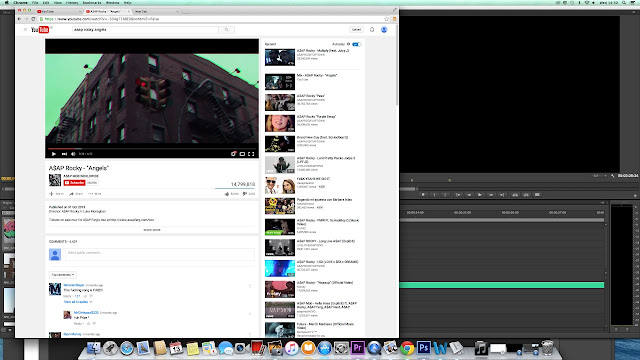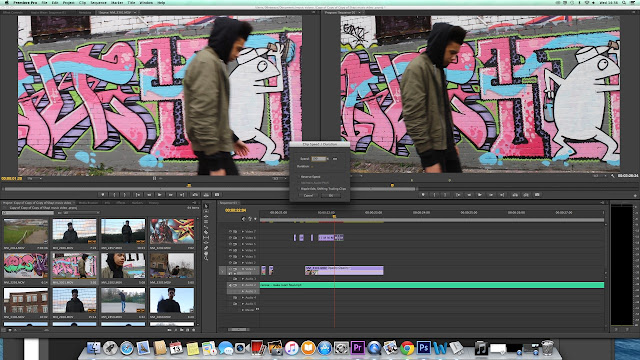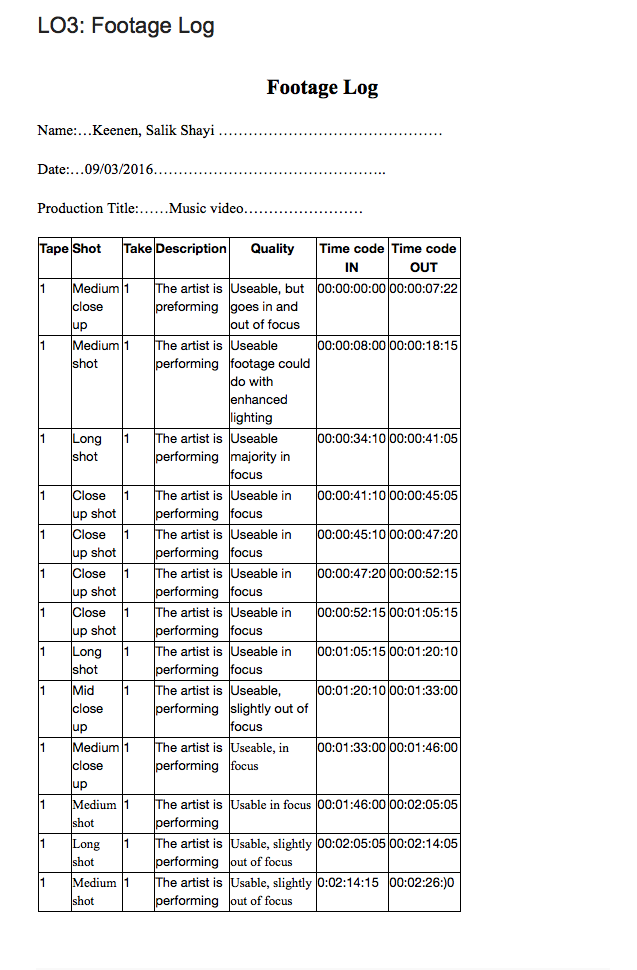My Contribution To 'Make Room' Muisc Video production
The role I played during the post production stage:
When I was editing for the Runcee 'Make Room' music video I arranged and enhanced the footage we filmed. I used multiple editing features that I was new too and familiar with in order to develop the music video.
Contribution to the music video:
When editing the music video I made sure the scenes were on beat with the music in order to keep the tempo fast paced, I did this by making sure that the jump cuts were on beat with the music and when the stutter sound effect occured I made sure there was a visual stutter within the scenes. I also changed the clips by scaling them in order for them to fit into the frame of the software I was using. I also manipulated the colourway at different times to give the scene a dystorted effect. I also did a lot of the placement of each clip within the video, I pieced it together so that the various lip syncing scenes matched the music, this was done by importing each of the video files in Premiere and place them in the correct order according to the music.
Evidence of editing
Here is my evidence of editing for the music videoEvidence of editing



Treatment:
The Brief
We've produced a music
video that promotes Runcee. The purpose of a treatment is to show the
client awareness that we know what we have been assigned in order to
create a music video that is designed for our target audience. In
addition to this we are using the treatment in order to indicate that
our music video idea has structure in order to gain more funding from
the client.
Target Audience
We will be producing a music video in the style of an independent warp style music video.
The target audience for
this music video we're going to produce will be aimed at people from the
ages of 18 within the ABC1 category on the demographic and scale. The
reason we chose this target audience is because some of the lyrical
content within this song is considered explicit, therefore inappropriate
for younger viewers, however younger viewers are likely to watch it
too.
Segment synopsis and how it relates to the brief
This music video will be a
performance video, this is due to the fact that we believe it would be
easier to present the music video in this style. This is because I
believe a performance video can truly capture the environment and the
background of the artist, therefore relating to the genre of music being
preformed.
Contingencies
In case something was to go
wrong I have considered a few other artists that would gladly offer me
their music to use for the music video, but first I would need to gain
their written permission before I could use their audio.
If my actors are unable to
attend a shoot, or have decided that they don't want to be in the video
anymore I must first ensure that I have got them to sign a release form.
The release form makes it less stressful for the production team by not
having them find a new audio, just a new actor.
I must also ensure that I have a few back up actors, this will help if any of the actors decide to opt out of the music video.
In case a location is
deemed as not suitable based on environmental factors. I think it is
smart if we consider different locations if our desired location is not
suitable. This is because it doesn't limit us in terms of when it comes
to filming.
Key Milestones
- All the planning will be done by the 5th of February
- Filming will start the 8th of February
- Editing will be the 18th of March
- Launch date will be the 22nd of March
Equipment
The equipment we will be needing to make our music video a success will be:
- 1X Canon 650D
- Tripod
- Costumes the model is wearing, this will relate to the genre of the music because grime is seen as street type music so street clothes would seem suitable for this music video.
Locations
Millhouses Park
Matilda Street
Models/actor
Shayi Aluwoade
will be peforming in the place of Runcee, due to the fact that Charles
is currently unavailable for the shoot at this current moment in time.
Shayi will be pretending to be Runcee for this video.
Health And Safety Consideration
-Weather conditions
Slippery surfaces and paths could be hazardous when preforming and could result to
the artist falling over whilst preforming.
-Camera damages
we
must wear the correct footware when using the cameras in order to
reduce the risk of falling with it. We must also wear the camera strap
in order to firmly secure the camera.
For each location we much produce:
A location recce form. This is a form informing us on if the chosen location is suitable for the shoot.
We need photographic evidence of what the location looks like.
And we also need to produce a Risk Assessment.
Legal, Ethical, Scheduling and Certification
We
need to gain permission from Runcee in order to use his audio for the
music video. If we do not seek permission from the artist be are
breaking the copyright law and we could end up getting prosecuted for
it.
Distribution
Our
group will be releasing this music video on YouTube, this is due to the
fact that it is considered a very popular site in terms of videos and
music, and it is also free to use. Another reason why we decided to
upload this video on YouTube is due to the fact that wqe have quite a
young target audience, which means quite a lot of them use technology
such as YouTube on the regular so it would be convenient for them if we
used YouTube in order to distribute our final video. Another site that
we've thought about distributing our music video on is Twitter, yet
again based on the fact that younger people that are within our target
audience will be using applications like Twitter so it would be
convenient for them to watch the videos that are uploaded on Twitter.
The final means of distributing the music video would be uploading the
video on facebook, there are millions of users that use Facebook daily,
so by uploading the video on a group page on facebook we're able to
attract Runcees followers and keep them informed on other videos coming
up.
The treatment sorted out all the problems that could occur before filming, like legal and ethical. And it kept us on track also when it came to our requirments needed for the shoot.

The gantt chart was a time check reminder for our group, this informed us how long each task should take us during the production of this music video.
This is the edit decision list, we made this before we actually began constructing footage for the actual music video in order for everything to be easy for us during the final steps of the production process. This contains information that is vital to each shot and gives a detailed description on the transitions we would need to take within scenes too.

The treatment sorted out all the problems that could occur before filming, like legal and ethical. And it kept us on track also when it came to our requirments needed for the shoot.
Gantt Chart

The gantt chart was a time check reminder for our group, this informed us how long each task should take us during the production of this music video.
Production Schedule
Here are two of the production schedules I had made. These production schedules helped us know what each memeber of the group would be doing day to day with editing of the music video.
Storyboards:
These are some of the storyboards that we developed. During the editing stage these were vital because they contained information on the various effects that we would use during the editing stage of production. However not all of our edits copntained the same ideas as what the storyboard reccomended, due to having seen better effects during actual editing and taking a better liking to these effects.
Edit Decision List
This is the edit decision list, we made this before we actually began constructing footage for the actual music video in order for everything to be easy for us during the final steps of the production process. This contains information that is vital to each shot and gives a detailed description on the transitions we would need to take within scenes too.
Footage Log

The footage log was a vital piece that helped us analyse our footage so we knew exactly what clips we would be using for the final music video. This gave us the shot information that helped us in deciding what footage we wanted and which we needed in the final piece.
Development Of My Skills:
I believe that my skills have increased dramatically ever since doing this project. This project has given me the skills to confidently use editing software, and working with a prodution team to meet a deadline set by a client. This gives you a sense of professionalism when working because you're trying to make a product to the best of your ability for a client. Being able to actually create something to my design, I can honestly say there is no better feeling than that. It brings you a great sense of control over your own work.
Additional Roles
Within the music video I was the sound technician also. Me and Shayi took it upon ourselves to equilize and manipulate the audio, in order to make the audio clear and match the clips being shown during the video. I removed all unnecessary sounds within the audio in order for the to know be any disruption within the sound and video footage. It was essentil for me to do this because we had quite a lot of activities going on in the background of the music video that we needed to dispose of.
Additional Roles
Within the music video I was the sound technician also. Me and Shayi took it upon ourselves to equilize and manipulate the audio, in order to make the audio clear and match the clips being shown during the video. I removed all unnecessary sounds within the audio in order for the to know be any disruption within the sound and video footage. It was essentil for me to do this because we had quite a lot of activities going on in the background of the music video that we needed to dispose of.














